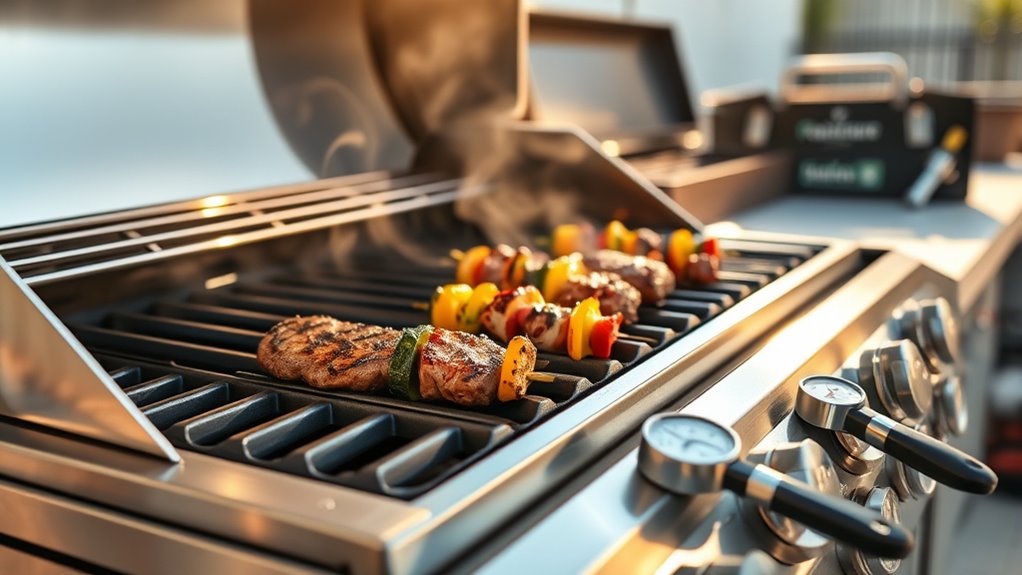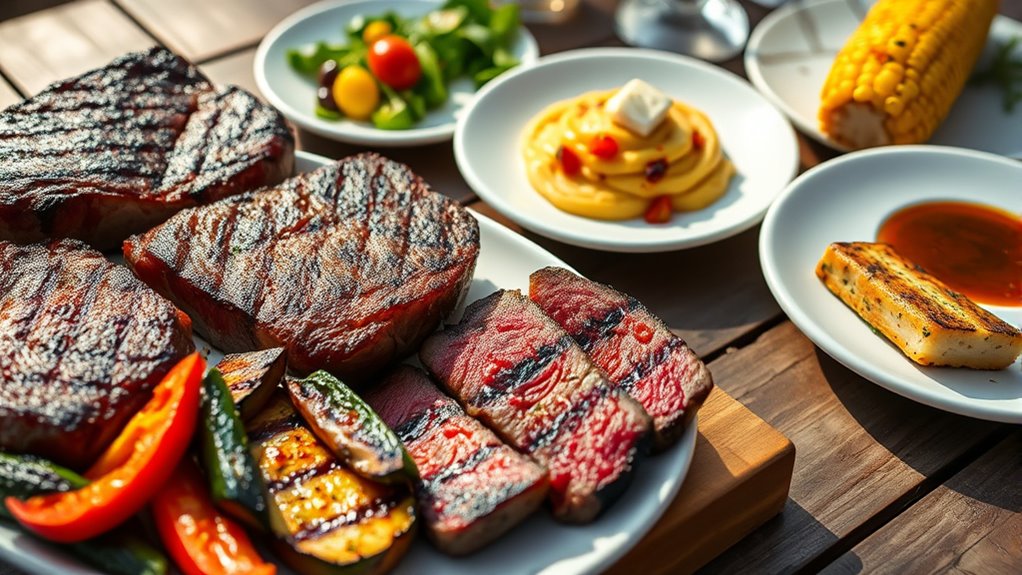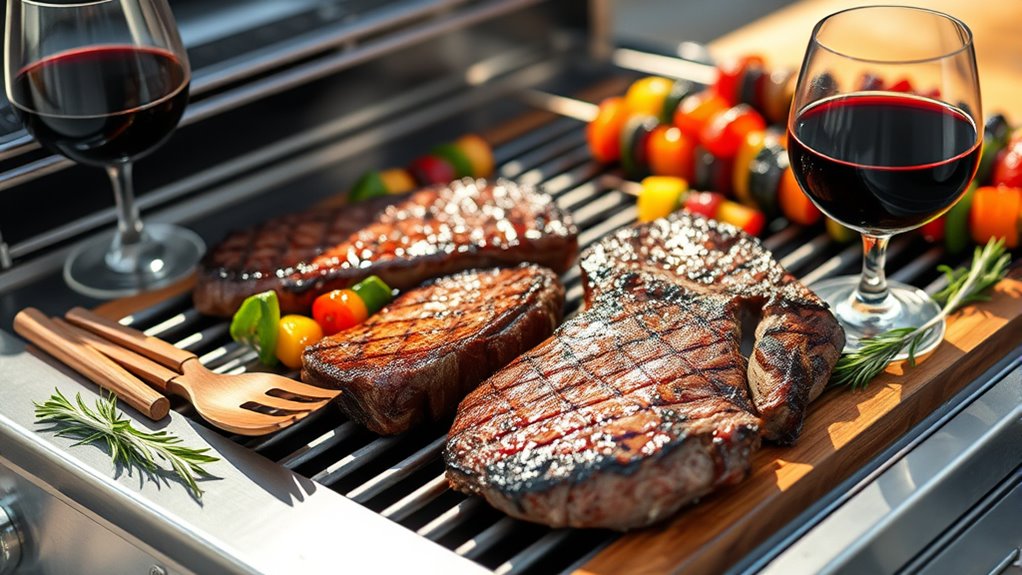To elevate your summer grilling, focus on mastering direct and modified techniques for perfect searing and slow cooking. Balance flavors with well-crafted marinades, rubs, and fresh herbs, and keep your equipment in top shape with regular cleaning and maintenance. Use seasonal ingredients creatively and present dishes beautifully for a luxurious touch. By controlling heat precisely and timing your cookouts, you’ll achieve gourmet results—keep exploring for more expert tips to impress your guests.
Key Takeaways
- Use high-quality, seasoned meats and fresh seasonal produce to elevate flavor and presentation.
- Incorporate gourmet marinades, herbs, and finishing sauces for complex, refined taste profiles.
- Master precise heat control with multiple zones for perfect searing and slow cooking.
- Enhance plating with colorful garnishes, edible flowers, and creative presentation techniques.
- Maintain your grill with thorough cleaning and regular maintenance for optimal performance and safety.
Mastering the Art of Direct and Modified Grilling Techniques

Mastering the art of direct and modified grilling techniques begins with understanding how to control heat effectively. Your first step is guaranteeing grill safety by choosing the right fuel. Gas grills allow quick temperature adjustments with precise knob controls, making it easier to maintain high heat for searing. When using charcoal, select quality briquettes that ignite evenly and burn consistently, providing reliable heat zones. Proper fuel selection helps you set up effective heat zones—hot for searing and cooler for finishing—crucial for direct grilling. Remember to preheat your grill thoroughly, whether gas or charcoal, to achieve consistent results. Managing airflow with vents or adjusting burners ensures safe operation and effective heat control. Controlling airflow is essential for maintaining consistent temperatures and preventing flare-ups. Mastering these basics lets you craft perfectly grilled dishes while maintaining safety and fuel efficiency.
Achieving Perfect Flavor Balance With Marinades, Rubs, and Herbs

Achieving the perfect flavor balance on your grill relies on understanding how marinades, rubs, and herbs work together to create harmony among the five primary tastes: sweet, salty, sour, bitter, and umami. Using effective marinade techniques, you can layer flavors—adding acids like citrus or vinegar, then balancing with sweetness from honey or fruit. Herb pairings like rosemary or mint enhance freshness and reduce strong or gamey flavors, especially in lamb. Incorporate herbs into rubs or finishing sauces to add brightness without bitterness. Remember, seasoning incrementally and tasting as you go guarantees no single flavor dominates. Understanding how each flavor element influences the others is crucial for developing a balanced and sophisticated flavor profile. By thoughtfully combining these elements, you’ll achieve a well-rounded, sophisticated flavor profile that elevates your summer grilling experience. Exploring flavor balance techniques can further refine your skills and result in more harmonious dishes.
Optimal Equipment Use and Maintenance for a Gourmet BBQ Experience

To guarantee your grill delivers consistently excellent results, proper equipment use and maintenance are essential. Regular grill cleaning is vital; after each use, scrub the grates thoroughly with a wire brush or grill scraper to remove food residue and prevent buildup. Follow this with a 10-minute high heat burn-off to eliminate grease and reduce flare-ups. Conduct monthly deep cleaning by removing the grates and scrubbing burners with warm, soapy water. Equipment lubrication also plays a crucial role—apply lubricant sprays on knobs, hinges, and seals to ensure smooth operation and a tight closure. Lightly oil the grill grates after cleaning to prevent rust and sticking. Regular cleaning maintains grate condition and cooking quality, and proper maintenance not only prolongs your equipment’s lifespan but also guarantees your grilling results stay top-notch every time. Incorporating effective maintenance routines can further enhance your grilling experience and preserve your investment.
Creative Seasonal Recipes and Presentation Ideas for End-of-Summer Grilling

As you wrap up your summer grilling season, it’s the perfect time to get creative with recipes and presentation ideas that celebrate bold flavors and vibrant visuals. Incorporate seasonal produce and sustainable sourcing to elevate your dishes. Consider plant-based alternatives like grilled veggie tacos or smoky mushroom skewers for variety and inclusivity. Use colorful garnishes such as microgreens, edible flowers, and citrus slices to brighten plates and add freshness. Present dishes creatively by serving grilled ribs on banana leaves or in mason jars for a modern touch. For sides, try bourbon peach baked beans or Sriracha street corn in ramekins. These ideas not only highlight the flavors of late summer but also emphasize eco-conscious choices that make your end-of-season BBQ memorable. Sustainable sourcing is increasingly important to many grill masters and diners alike, ensuring that your grilling practices support environmental responsibility while still delivering exceptional flavor. Incorporating seasonal ingredients can also enhance the freshness and appeal of your dishes, making your end-of-summer feast truly memorable.
Temperature Control and Timing Strategies for Gourmet Results

Controlling temperature and timing is essential for gourmet grilling results, ensuring your dishes are cooked perfectly and retain their flavor and texture. To do this, use a reliable grill thermometer to monitor internal and ambient temperatures constantly. Create multiple heat zones—hot for searing, low for slow cooking—by adjusting burners or dampers, and regulate airflow to maintain consistent heat. Proper heat insulation, like heat shields or aluminum foil, prevents flare-ups and temperature spikes, enhancing grill safety. Open or close lids strategically to trap heat and control airflow, stabilizing temperature. Use timers and probes to track cooking stages, especially when shifting from searing to gentle roasting. These precise adjustments help you achieve restaurant-quality results while ensuring your grilling setup remains safe and well-managed. Effective temperature control not only improves the quality of your grilled dishes but also extends the lifespan of your equipment by reducing wear and tear caused by temperature fluctuations. Additionally, staying informed about home security systems can provide peace of mind during outdoor cooking sessions.
Frequently Asked Questions
How Can I Incorporate Exotic Spices Into My Gourmet Grilling Recipes?
Imagine your grill becoming a canvas for vibrant, worldly flavors. You can incorporate exotic spice blends into your recipes using flavor infusion techniques like dry rubs, marinades, and spice-infused oils. Freshly ground spices like cumin, coriander, and smoked paprika add depth, while marinating meats with curry paste or coconut milk enhances aroma. This approach transforms simple grilling into a luxurious, globally inspired feast, elevating your summer cookouts effortlessly.
What Are the Best Ways to Prevent Food From Sticking to Stainless Steel Grates?
To prevent food from sticking to stainless steel grates, you should start with a well-seasoned cast iron or properly seasoned grates, which develop a natural non-stick surface. Before grilling, apply a thin oil coating using high smoke point oils, ensuring an even layer. Preheat your grill to around 400°F, then place food once hot. Regular maintenance, including cleaning and re-oiling, keeps the surface slick and reduces sticking over time.
How Do I Choose the Right Wood Chips for Smoking Different Meats?
When choosing wood chips for smoking, consider your meat’s flavor profile and desired smoke flavor intensity. For lighter meats like poultry and fish, opt for milder woods like apple or alder. Heavier meats like beef and pork call for stronger woods such as hickory or mesquite. Mixing different woods can create a balanced smoke flavor, enhancing your meat’s natural taste. Always match your wood selection to the meat’s robustness for the best results.
What Techniques Can Enhance the Presentation of Grilled Dishes for a Gourmet Table?
You might think presentation is just aesthetics, but it profoundly influences how your dish is perceived. Using plating techniques like landscape or rule of thirds adds visual interest, while height and texture create depth. Garnishing tips, such as contrasting colors and edible accents, elevate the look. Carefully arranging components, cleaning edges, and choosing complementary plates ensure your grilled dishes look as impressive as they taste, making every serving a gourmet experience.
How Can I Efficiently Manage Multiple Dishes on Different Heat Zones Simultaneously?
To manage multiple dishes on different heat zones efficiently, plan your cooking sequence around plating techniques and sauce pairings. Use high-heat zones for quick searing and low-heat zones for slow roasting or finishing. Keep dishes organized by their required temperatures, and monitor internal temps with thermometers. This way, you can plate each dish at its ideal moment, ensuring perfect presentation and flavor harmony while preventing overcooking or cross-contamination.
Conclusion
So, after all that fuss over perfect techniques and fancy marinades, you might think you’re now a grilling guru. But don’t forget—sometimes the real art is just flipping burgers without losing your patience. As summer slips away, enjoy the chaos and charm of gourmet grilling. Because in the end, no matter how refined your approach, a little burnt humor and good company make every BBQ unforgettable. Happy end-of-summer grilling!









